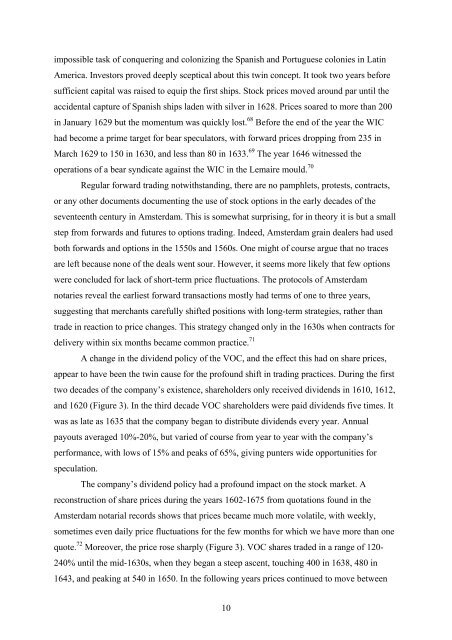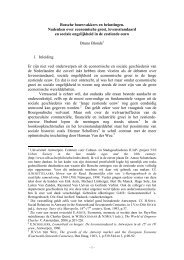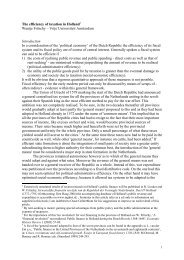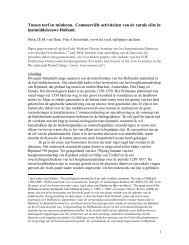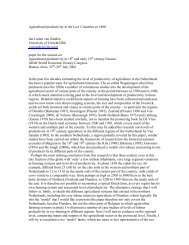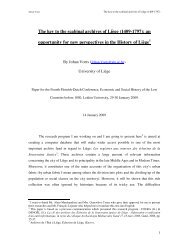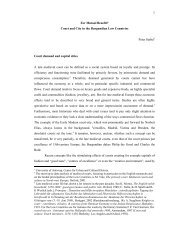Amsterdam as the cradle of modern futures and options trading ...
Amsterdam as the cradle of modern futures and options trading ...
Amsterdam as the cradle of modern futures and options trading ...
You also want an ePaper? Increase the reach of your titles
YUMPU automatically turns print PDFs into web optimized ePapers that Google loves.
impossible t<strong>as</strong>k <strong>of</strong> conquering <strong>and</strong> colonizing <strong>the</strong> Spanish <strong>and</strong> Portuguese colonies in Latin<br />
America. Investors proved deeply sceptical about this twin concept. It took two years before<br />
sufficient capital w<strong>as</strong> raised to equip <strong>the</strong> first ships. Stock prices moved around par until <strong>the</strong><br />
accidental capture <strong>of</strong> Spanish ships laden with silver in 1628. Prices soared to more than 200<br />
in January 1629 but <strong>the</strong> momentum w<strong>as</strong> quickly lost. 68 Before <strong>the</strong> end <strong>of</strong> <strong>the</strong> year <strong>the</strong> WIC<br />
had become a prime target for bear speculators, with forward prices dropping from 235 in<br />
March 1629 to 150 in 1630, <strong>and</strong> less than 80 in 1633. 69 The year 1646 witnessed <strong>the</strong><br />
operations <strong>of</strong> a bear syndicate against <strong>the</strong> WIC in <strong>the</strong> Lemaire mould. 70<br />
Regular forward <strong>trading</strong> notwithst<strong>and</strong>ing, <strong>the</strong>re are no pamphlets, protests, contracts,<br />
or any o<strong>the</strong>r documents documenting <strong>the</strong> use <strong>of</strong> stock <strong>options</strong> in <strong>the</strong> early decades <strong>of</strong> <strong>the</strong><br />
seventeenth century in <strong>Amsterdam</strong>. This is somewhat surprising, for in <strong>the</strong>ory it is but a small<br />
step from forwards <strong>and</strong> <strong>futures</strong> to <strong>options</strong> <strong>trading</strong>. Indeed, <strong>Amsterdam</strong> grain dealers had used<br />
both forwards <strong>and</strong> <strong>options</strong> in <strong>the</strong> 1550s <strong>and</strong> 1560s. One might <strong>of</strong> course argue that no traces<br />
are left because none <strong>of</strong> <strong>the</strong> deals went sour. However, it seems more likely that few <strong>options</strong><br />
were concluded for lack <strong>of</strong> short-term price fluctuations. The protocols <strong>of</strong> <strong>Amsterdam</strong><br />
notaries reveal <strong>the</strong> earliest forward transactions mostly had terms <strong>of</strong> one to three years,<br />
suggesting that merchants carefully shifted positions with long-term strategies, ra<strong>the</strong>r than<br />
trade in reaction to price changes. This strategy changed only in <strong>the</strong> 1630s when contracts for<br />
delivery within six months became common practice. 71<br />
A change in <strong>the</strong> dividend policy <strong>of</strong> <strong>the</strong> VOC, <strong>and</strong> <strong>the</strong> effect this had on share prices,<br />
appear to have been <strong>the</strong> twin cause for <strong>the</strong> pr<strong>of</strong>ound shift in <strong>trading</strong> practices. During <strong>the</strong> first<br />
two decades <strong>of</strong> <strong>the</strong> company’s existence, shareholders only received dividends in 1610, 1612,<br />
<strong>and</strong> 1620 (Figure 3). In <strong>the</strong> third decade VOC shareholders were paid dividends five times. It<br />
w<strong>as</strong> <strong>as</strong> late <strong>as</strong> 1635 that <strong>the</strong> company began to distribute dividends every year. Annual<br />
payouts averaged 10%-20%, but varied <strong>of</strong> course from year to year with <strong>the</strong> company’s<br />
performance, with lows <strong>of</strong> 15% <strong>and</strong> peaks <strong>of</strong> 65%, giving punters wide opportunities for<br />
speculation.<br />
The company’s dividend policy had a pr<strong>of</strong>ound impact on <strong>the</strong> stock market. A<br />
reconstruction <strong>of</strong> share prices during <strong>the</strong> years 1602-1675 from quotations found in <strong>the</strong><br />
<strong>Amsterdam</strong> notarial records shows that prices became much more volatile, with weekly,<br />
sometimes even daily price fluctuations for <strong>the</strong> few months for which we have more than one<br />
quote. 72 Moreover, <strong>the</strong> price rose sharply (Figure 3). VOC shares traded in a range <strong>of</strong> 120-<br />
240% until <strong>the</strong> mid-1630s, when <strong>the</strong>y began a steep <strong>as</strong>cent, touching 400 in 1638, 480 in<br />
1643, <strong>and</strong> peaking at 540 in 1650. In <strong>the</strong> following years prices continued to move between<br />
10


